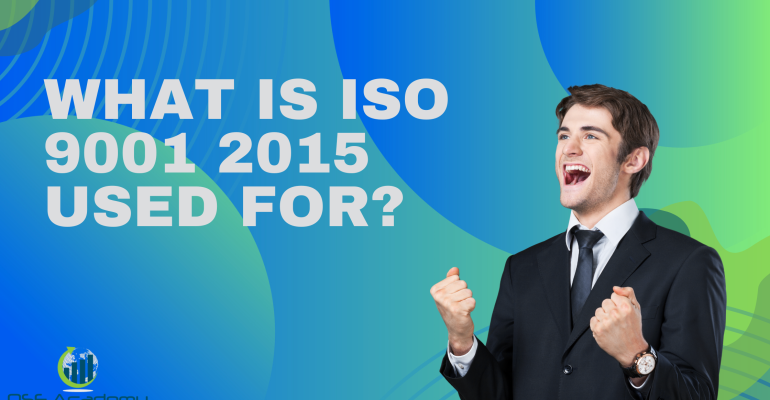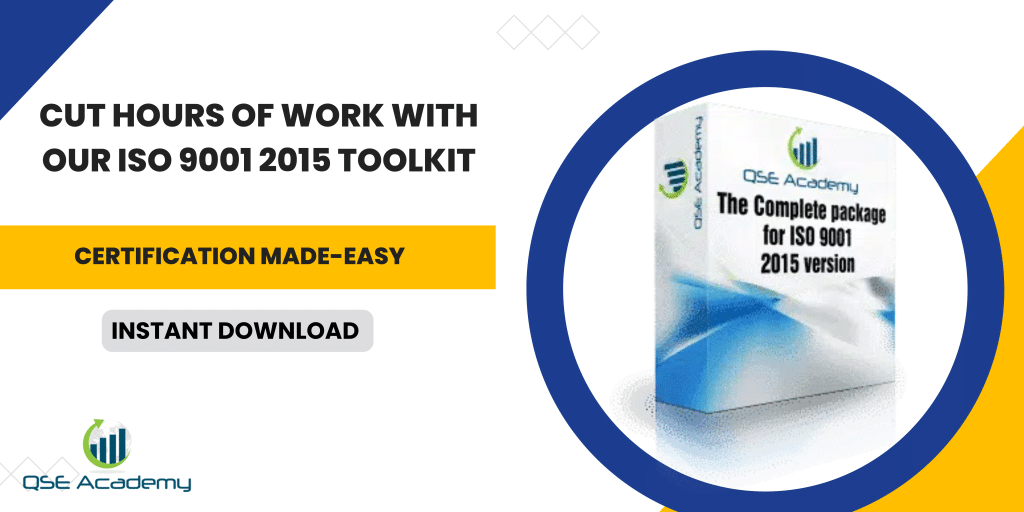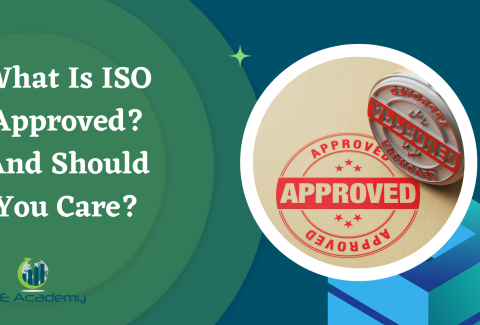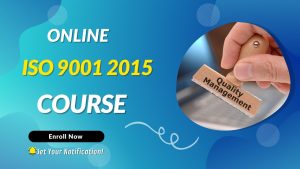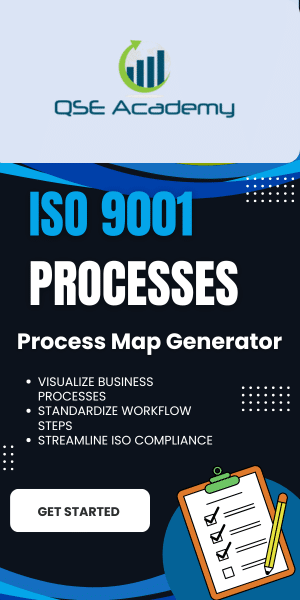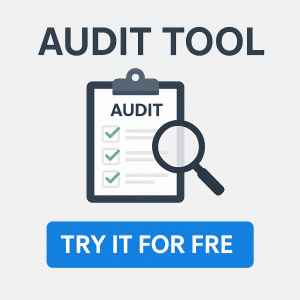What is ISO 9001 2015 used for?
Last Updated on October 13, 2025 by Hafsa J.
What is ISO 9001 2015 used for?
Have you ever wondered how businesses maintain consistency, improve quality, and keep their customers happy all at the same time? The answer often lies in having a strong framework to guide them—and that’s where ISO 9001:2015 comes in. But what is ISO 9001 2015 used for, exactly? Let’s break it down together.
ISO 9001:2015 is an international standard designed to help organizations create and maintain effective Quality Management Systems (QMS). It’s like a toolkit that businesses can use to streamline processes, ensure products or services meet customer expectations, and keep improving over time.
The beauty of ISO 9001:2015 is that it’s incredibly versatile. Whether you’re running a manufacturing company, a service-based business, or even a small startup, the standard can be tailored to fit your needs. It’s used for everything from improving efficiency to gaining a competitive edge in the marketplace.
In this article, we’ll dive into the many ways ISO 9001:2015 is used across industries, why it’s so valuable, and how it helps organizations of all sizes achieve their goals. So, if you’re curious about what ISO 9001 2015 is used for, you’re in the right place! Let’s get started.
Understanding the Basics of ISO 9001 2015
Before we dive into the details of what ISO 9001 2015 is used for, let’s take a moment to understand what it is and why it’s so important. ISO 9001:2015 is part of the ISO 9000 family of standards, which focuses on Quality Management Systems (QMS). But unlike other standards, ISO 9001:2015 is the one that organizations can get certified in—and it’s widely recognized as the gold standard for managing quality across industries.
What is ISO 9001:2015?
In simple terms, ISO 9001:2015 is a framework that helps businesses ensure they’re delivering consistent quality in their products or services. Think of it as a playbook for running your organization more efficiently, meeting customer expectations, and improving processes over time.
The “2015” part refers to the year the latest version was released, which brought in some new ideas, like risk-based thinking and a stronger focus on leadership. These updates make the standard even more practical and relevant for today’s fast-paced business world.
Why Do Organizations Use ISO 9001 2015?
So, what is ISO 9001 2015 used for on a practical level? At its core, it’s used to help businesses improve their operations and deliver better results. Here’s why organizations across the globe rely on it:
- To Ensure Consistency
Customers love consistency. Whether it’s the taste of their favorite coffee or the reliability of a software service, delivering the same high quality every time builds trust. ISO 9001:2015 helps businesses standardize their processes so they can consistently meet customer expectations. - To Improve Efficiency
Let’s face it—waste, inefficiency, and unclear processes are a headache for any business. ISO 9001:2015 is used to streamline workflows, eliminate unnecessary steps, and ensure resources are used effectively. - To Manage Risks
One of the standout features of ISO 9001:2015 is its focus on risk-based thinking. It’s used by organizations to identify potential problems before they happen and put measures in place to address them proactively. - To Foster Continuous Improvement
Businesses don’t just want to stay the same—they want to get better. ISO 9001:2015 encourages organizations to keep evolving by monitoring performance, gathering feedback, and making improvements over time. - To Build Credibility and Trust
Certification to ISO 9001:2015 is a powerful way to show customers and partners that your business takes quality seriously. It’s used to boost credibility and open doors to new opportunities in competitive markets.
By understanding these basics, it’s easier to see how ISO 9001:2015 serves as more than just a standard—it’s a tool for growth, efficiency, and success. In the next section, we’ll explore the specific ways the standard is applied in real-world scenarios to help businesses thrive. Let’s keep going!
Key Areas Where ISO 9001 2015 is Used
Now that we’ve covered the basics, let’s dive deeper into what ISO 9001 2015 is used for in real-world settings. The beauty of this standard is its flexibility—it can be applied to virtually any industry or organization, whether big or small. At its core, ISO 9001:2015 helps businesses improve quality, streamline operations, and keep customers happy. Let’s take a closer look at how it’s used in different areas.
1. Streamlining Internal Processes
One of the main reasons organizations implement ISO 9001:2015 is to improve the way they operate. The standard is used to document and optimize processes, making them more efficient and consistent.
For example, in a manufacturing business, ISO 9001:2015 might be used to establish clear procedures for production, quality checks, and inventory management. This reduces errors, minimizes waste, and ensures every product meets the same high standards.
In service-based industries, the standard might be applied to improve workflows, such as how customer inquiries are handled or how services are delivered. The result? A smoother operation that benefits both the organization and its customers.
2. Improving Customer Satisfaction
Let’s face it—happy customers are the backbone of any successful business. That’s why one of the key things ISO 9001 2015 is used for is ensuring customer satisfaction. The standard emphasizes understanding what customers want, delivering on those expectations, and continually improving to keep them coming back.
For example, ISO 9001:2015 might be used to implement a process for gathering and acting on customer feedback. If customers frequently mention slow response times, the organization can use this insight to improve communication processes and exceed expectations.
3. Managing Risks and Preventing Problems
Risk management is a standout feature of ISO 9001:2015, and it’s used by organizations to stay ahead of potential issues. By identifying risks early, businesses can take proactive steps to prevent problems before they happen.
For instance, a company might use ISO 9001:2015 to assess risks in its supply chain, such as delays or quality issues from vendors. By addressing these risks proactively—like finding alternative suppliers or improving supplier relationships—they can avoid disruptions and maintain smooth operations.
4. Enhancing Employee Engagement and Accountability
Employees are the heart of any organization, and ISO 9001:2015 is often used to create an environment where they feel engaged and empowered. The standard emphasizes clear communication, well-defined roles, and accessible training, which helps employees understand their responsibilities and how their work contributes to overall quality.
For example, an organization might use ISO 9001:2015 to implement a structured onboarding process that equips new hires with the knowledge and tools they need to succeed. This not only boosts morale but also ensures everyone is working toward the same quality goals.
5. Meeting Regulatory and Market Requirements
Many industries have strict regulations or market expectations, and ISO 9001:2015 is often used to help businesses comply with these requirements. From food safety to environmental regulations, the standard provides a structured approach to ensure compliance without adding unnecessary complexity.
For instance, a healthcare organization might use ISO 9001:2015 to ensure its processes meet both regulatory standards and patient care expectations. This not only avoids penalties but also builds trust with stakeholders.
6. Gaining a Competitive Edge
In today’s competitive market, businesses are always looking for ways to stand out. ISO 9001:2015 is used to build credibility and demonstrate a commitment to quality, which can be a major selling point for potential clients or customers.
For example, a small business might use its ISO 9001:2015 certification to show that, even as a smaller operation, it follows global standards for quality. This can level the playing field against larger competitors and attract new opportunities.
How These Applications Work Together
When you look at all these areas, it’s clear that ISO 9001 2015 is used for much more than just improving processes. It’s a tool for building trust, fostering a culture of quality, and ensuring long-term success.
In the next section, we’ll explore specific real-world examples of how organizations use ISO 9001:2015 to achieve their goals. Stick with me—it’s about to get even more practical!
Real-World Examples of What ISO 9001 2015 is Used For
Now that we’ve talked about the different areas where ISO 9001:2015 is applied, let’s look at some real-world examples of what ISO 9001 2015 is used for. Seeing how businesses and organizations use this standard can help you understand its practical value and how it might work for your own operations.
1. Manufacturing Industry: Ensuring Product Consistency
In the manufacturing world, consistency is everything. Imagine a company that produces car parts. If even one batch of parts doesn’t meet the required specifications, it could lead to recalls, safety issues, and dissatisfied customers.
This is exactly where ISO 9001:2015 shines. By using the standard, manufacturers can create detailed processes for production, quality checks, and final inspections. They can also identify risks, like equipment failures, and plan maintenance schedules to minimize downtime.
In this scenario, ISO 9001 2015 is used for ensuring that every product meets the same high-quality standard, protecting both the company’s reputation and its customers.
2. Service Industry: Improving Customer Experiences
Let’s shift to the service industry. Imagine a hotel chain that wants to improve guest satisfaction across all its locations. ISO 9001:2015 can be used to establish consistent service standards—like how quickly rooms are cleaned, how staff handle customer requests, and how complaints are resolved.
For example, a hotel might use customer feedback (a key part of ISO 9001:2015) to identify recurring issues, like slow check-ins. By analyzing this data, they could streamline their check-in process and train staff to handle peak times more effectively.
Here, ISO 9001 2015 is used for creating a smoother, more enjoyable experience for guests, which builds loyalty and encourages positive reviews.
3. Healthcare: Enhancing Patient Care
In healthcare, quality isn’t just about customer satisfaction—it can directly impact lives. Hospitals and clinics often use ISO 9001:2015 to ensure patient care processes are efficient, safe, and consistently applied.
For example, a hospital might use ISO 9001:2015 to create standardized procedures for handling patient records, managing medication, or responding to emergencies. Regular performance evaluations (required by the standard) help identify areas for improvement, such as reducing wait times or improving communication with patients.
In this context, ISO 9001 2015 is used for delivering better healthcare outcomes and building trust with patients and their families.
4. Small Businesses: Building Credibility
ISO 9001:2015 isn’t just for large corporations. Small businesses often use the standard to build credibility and compete in bigger markets.
Take, for instance, a family-owned food production company. By implementing ISO 9001:2015, they can demonstrate that their processes meet international quality standards. This can open doors to new customers, distributors, or even global markets.
For them, ISO 9001 2015 is used for gaining an edge in competitive industries and showing they’re serious about quality.
5. Technology Companies: Managing Complex Projects
In the fast-paced tech world, managing complex projects and delivering reliable results can be a challenge. ISO 9001:2015 helps tech companies streamline their workflows and ensure consistent quality in their products or services.
For example, a software development company might use the standard to create processes for coding, testing, and client feedback. By doing so, they can deliver projects on time, within budget, and with fewer bugs.
In this industry, ISO 9001 2015 is used for keeping projects on track and building trust with clients.
Why These Examples Matter
As you can see, what ISO 9001 2015 is used for varies widely across industries, but the end goal is always the same: to improve quality, enhance efficiency, and keep customers happy. Whether it’s a hospital improving patient care, a hotel streamlining service, or a small business gaining credibility, the standard adapts to meet the unique needs of each organization.
In the next section, we’ll discuss how businesses can maximize the benefits of ISO 9001:2015 and take their quality management to the next level. Stick around—we’re almost there!
How to Maximize the Benefits of ISO 9001:2015
By now, you’ve got a solid understanding of what ISO 9001 2015 is used for and how it can help businesses improve quality and efficiency. But simply implementing the standard isn’t enough—you need to use it effectively to get the most out of it. Let’s explore some practical tips to help you maximize the benefits of ISO 9001:2015.
1. Align ISO 9001:2015 with Your Business Goals
One of the smartest ways to use ISO 9001:2015 is to integrate it into your overall business strategy. Instead of treating it as a separate initiative, think of it as a tool that helps you achieve your broader goals.
For example, if one of your goals is to reduce customer complaints, ISO 9001:2015 can help by setting up a process to gather, analyze, and act on customer feedback. Or, if you want to expand into new markets, the credibility of being ISO-certified can open doors.
By aligning the standard with your objectives, you’ll see exactly how ISO 9001 2015 is used for driving measurable improvements in your business.
2. Engage Your Team
Your employees play a crucial role in the success of your Quality Management System (QMS). To truly maximize the benefits of ISO 9001:2015, you need to get your team involved and motivated.
Start by educating them about what ISO 9001 2015 is used for and why it’s important. Show them how their roles contribute to the bigger picture, whether it’s through maintaining processes, identifying risks, or coming up with ideas for improvement.
When employees feel empowered and valued, they’re more likely to embrace the QMS and actively contribute to its success.
3. Focus on Continuous Improvement
One of the best things about ISO 9001:2015 is its emphasis on continuous improvement. To make the most of this, regularly evaluate your performance and look for ways to get better.
For example, you might use ISO 9001:2015 to track key performance indicators (KPIs) like customer satisfaction, process efficiency, or defect rates. Use the data to identify trends, address issues, and implement changes that drive improvement.
In this way, ISO 9001 2015 is used for creating a culture where improvement isn’t just a one-time effort—it’s an ongoing process.
4. Leverage Technology
Technology can make it much easier to manage and monitor your QMS. From document control software to tools for tracking performance metrics, there are plenty of resources that align perfectly with ISO 9001:2015.
For instance, you can use digital tools to manage controlled documents, ensuring everyone always has access to the latest procedures. Similarly, you can use software to automate performance tracking and reporting, saving time and reducing errors.
By integrating technology, you’ll see how ISO 9001 2015 is used for simplifying processes and making your QMS more efficient.
5. Regularly Review and Update Your QMS
Your business is constantly evolving, and your QMS should evolve with it. Regularly review your processes, policies, and goals to ensure they’re still aligned with your organization’s needs and the requirements of ISO 9001:2015.
For example, if your business introduces new products or expands into a new market, update your QMS to reflect these changes. This ensures that the system remains relevant and continues to deliver value.
In this way, ISO 9001 2015 is used for adapting to change and maintaining high standards in a dynamic environment.
6. Communicate the Value to Stakeholders
Finally, don’t forget to share the value of ISO 9001:2015 with your stakeholders—whether they’re customers, partners, or employees. Being ISO-certified is a powerful way to demonstrate your commitment to quality and consistency.
For example, you can highlight your ISO 9001:2015 certification in marketing materials, on your website, or during sales pitches. It’s a great way to build trust and set your business apart from competitors.
This is yet another way ISO 9001 2015 is used for gaining a competitive edge and building stronger relationships with stakeholders.
Making ISO 9001:2015 Work for You
Maximizing the benefits of ISO 9001:2015 isn’t about checking boxes—it’s about fully embracing the standard as a tool to improve your business. Whether it’s aligning it with your goals, empowering your team, or leveraging technology, there are countless ways to make ISO 9001:2015 work for you.
In the next section, we’ll wrap up everything we’ve discussed and highlight the key takeaways about what ISO 9001 2015 is used for. Stay with me—we’re almost there!
Conclusion: What is ISO 9001 2015 Used For?
So, let’s bring it all together. What is ISO 9001 2015 used for? At its core, it’s a tool that helps businesses of all shapes and sizes improve quality, streamline operations, and deliver better results for their customers. Whether you’re in manufacturing, healthcare, tech, or any other industry, ISO 9001:2015 provides a proven framework for achieving success.
Why ISO 9001:2015 Matters
ISO 9001:2015 is used for so much more than just ticking off compliance boxes or passing audits. It’s a game-changer for organizations that want to:
- Consistently meet or exceed customer expectations.
- Reduce waste and improve operational efficiency.
- Build credibility and gain a competitive edge.
- Identify and address risks before they become problems.
- Create a culture of continuous improvement and innovation.
By embracing the standard and integrating it into your business strategy, you’re not just improving processes—you’re building trust with customers, employees, and stakeholders.
Making ISO 9001:2015 Work for You
If there’s one thing to take away, it’s this: ISO 9001:2015 isn’t a one-size-fits-all solution. It’s designed to be flexible, so you can tailor it to your organization’s unique needs and goals. That’s why it’s used across industries—from small startups looking to establish credibility to global corporations managing complex supply chains.
So, if you’ve been asking yourself, “What is ISO 9001 2015 used for?” the answer is simple: it’s used to make your business better, more efficient, and more competitive. And the best part? It’s not just about where you are today—it’s about where you’re going and how this standard can help you get there.
Final Thoughts
ISO 9001:2015 is more than just a standard—it’s a roadmap to success. By understanding how it works and applying it effectively, you’re setting your organization up for long-term growth and improvement. Whether you’re aiming to reduce errors, enhance customer satisfaction, or improve your overall operations, ISO 9001:2015 is the tool you need to make it happen.
So, what’s your next step? Dive into the principles of ISO 9001:2015, align them with your business goals, and start reaping the rewards. You’ve got everything you need to take your organization to the next level. Let’s get started!
Ready to move from ISO 9001 theory to implementation?
Get the exact tools you need to write your documentation, train your team, map your processes, and pass your audit—without wasted time or guesswork.

make ISO standards less intimidating and more approachable for everyone.
Whether it’s ISO 9001, ISO 22000, or the cosmetics-focused ISO 22716, I’ve spent my career
turning complex jargon into clear, actionable steps that businesses can actually use.
I’m not here to call myself an expert—I prefer “enthusiast” because I truly love what I do.
There’s something incredibly rewarding about helping people navigate food safety and quality management systems
in a way that feels simple, practical, and even enjoyable.
When I’m not writing about standards, you’ll probably find me playing Piano 🎹, connecting with people, or diving into my next big project💫.
I’m an engineer specialized in the food and agricultural industry
I have a Master’s in QHSE management and over 12 years of experience as a Quality Manager
I’ve helped more than 15 companies implement ISO 9001, ISO 22000, ISO 22716, GMP, and other standards
My clients include food producers, cosmetics manufacturers, laboratories, and service companies
I believe quality systems should be simple, useful, and efficient.

